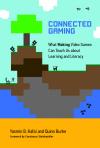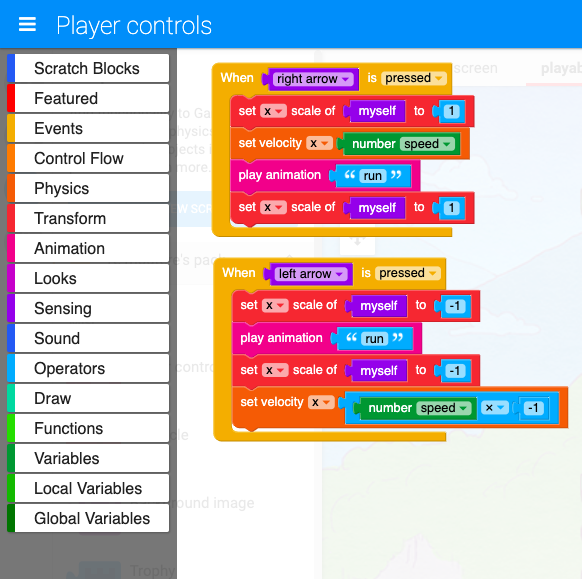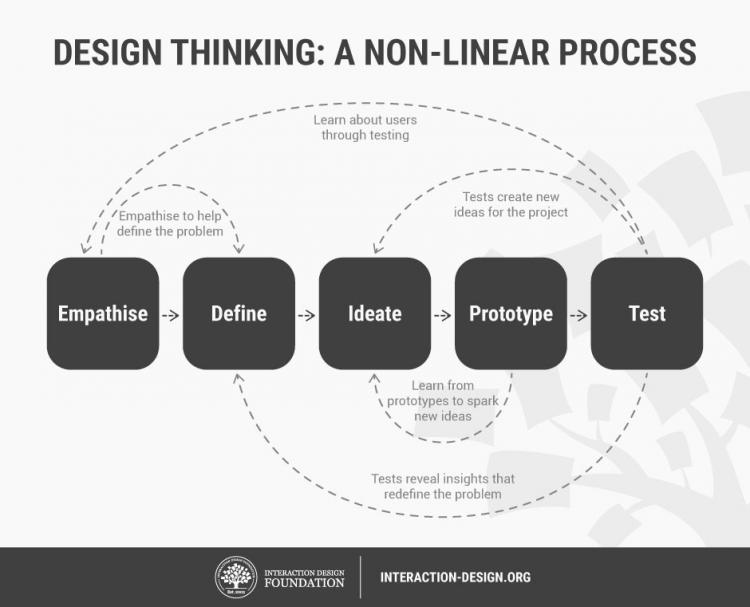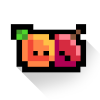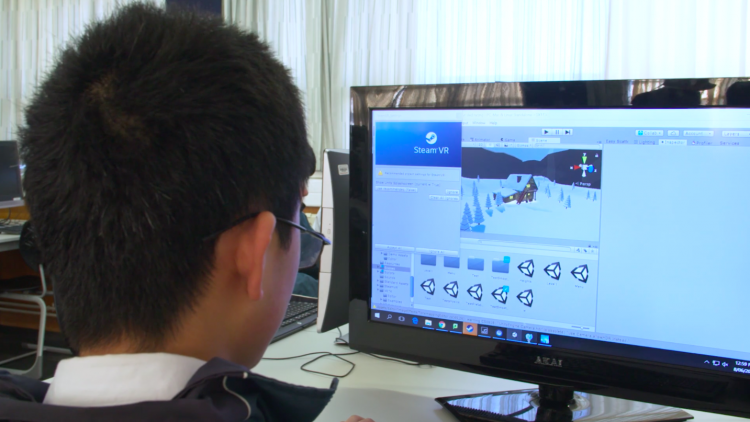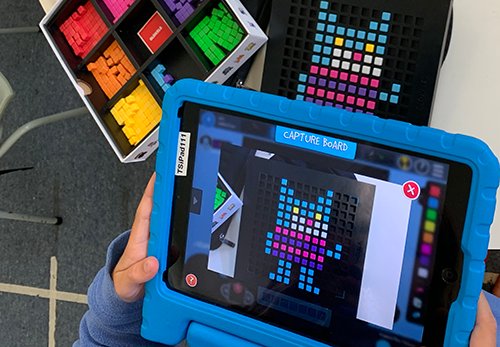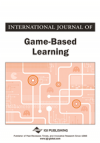Game development in the classroom
Why include game development in your local curriculum?
Game design is a useful context for developing computational thinking and digital creativity. When learners are introduced to software development at an early age, they need contexts that are familiar. Games present worlds with defined rules, clear objectives, and more than one possible solution to a problem.
- Developing games equips students with valuable STEM skills and dispositions, from coding and programming to computational and design thinking.
- Game design provides an authentic context for learning – students make their own choices, find solutions to problems, and lead the design process.
- Engagement is often high – digital games tap into the interests of young gamers eager to create their own games.
To get started with game development in your classroom try Te Hiko Tākaro . It's a complete unit of work covering the whole process from design through to development and sharing of the finished product.
Game-based learning, game development, and gamification – what's the difference?
- Game development is the process of designing and creating a digital game.
- Game-based learning and gamification are both trying to solve a problem, motivate, and promote learning using game-based thinking and techniques. See Gamification for more information.
Students from Pakuranga College describe the 3D virtual reality game, Totally realistic sledding , they created as a collaborative project, and the skills they developed through the process.
"In these classrooms, playing and making digital games were valued learning activities, linking students with industry tools and practices, and cultivating their problem-solving and design skills."
– Rachel Bolstad and Sue McDowell: Games, gamification, and game design for learning
Benefits for student learning
When students design games, they develop:
- digital capabilities such as coding, programming, game-art design, animating, and 3D modelling
- proficiency in programming concepts and computer science principals like computational thinking
- potential strengths, skills, and talents that students may not have been initially aware of
- core technology area competencies like design thinking and problem-solving
- critical understandings of games as interactive, social texts made up of complex narratives, systems, and game mechanics
- professional game design knowledge, along with many skills that are transferrable to different STEM fields.
More information »
NZCER: Games, gamification, and game design for learning
This report discusses the potential of games to support learning, and what innovative game-based (or “gameful”) learning and teaching practices can look like in a range of New Zealand school settings.
Super Street Arcade: into the ‘Dragon’s Den’!
Christchurch high school students develop games to be played on a public arcade.
Connected gaming: What making video games can teach us about learning and literacy
This book along with resources and materials for game design in the classroom are available from Yasmin Kafai's website. She and Quinn Burke research electronic gaming and learning.
When using game development as a context for learning, it's important for students to reflect on what they do and why. Framing game design within an authentic context and using relevant pedagogical approaches helps to consolidate learning.
Key approaches to consider when planning a game development unit in the classroom include:
- computational thinking
- design thinking
- game-based learning.
Computational thinking
"Computational thinking enables students to express problems and formulate solutions in ways that means a computer (an information processing agent) can be used to solve them."
When students develop games, they write scripts to:
- tell game objects how to behave
- automate enemies
- enable player controls
- set their own conditions for winning and losing.
During the process, they will encounter bugs in their code, find logical solutions to problems, and create original programming. In this way, students learn core programming concepts through game design.
More information »
Technology online – Computational thinking: Progress outcomes, exemplars, and snapshots.
The skills students gain through game development link directly to the computational thinking progress outcomes in Technology learning area of The New Zealand Curriculum.
Computational thinking in constructionist video games
This paper describes how constructionist video games are well suited for developing learners’ computational thinking skills.
Design thinking
Design thinking is an iterative process that provides a solution-based approach to solving problems. Design thinking could provide a supportive framework for developing digital games that take audience and purpose into account.
"With its focus on design thinking, technology education supports students to be innovative, reflective and critical in designing new models, products, software, systems and tools that will benefit people, while expressing empathy for the cultural, ethical, environmental, political, and economic conditions of the day."
– Technology in The New Zealand Curriculum , Ministry of Education, 2017
More information »
At meaningful play: Design thinking X game design
In this blog post, Mars Ashton discusses the role design thinking as a universal go-to for making good games.
3 steps to creating student design teams
Nicole Kreuger profiles Steve Isaacs’s eighth-grade classroom, who use design thinking to create a range of games.
Design thinking on Enabling e-Learning
This page delves deeper into design thinking and how it can be used to innovate, prototype, and create.
Design thinking for educators
IDEO's resources contain examples, school stories, and toolkits for teachers ready to bring design thinking into the classroom.
Game-based learning
Alongside the valuable learning that comes from game development, using games as contexts for further exploration and study can lead to new understandings of society and how human beings interact with one another.
Game-based learning understands games as texts made up of rules, stories, and systems that generate important social interactions.
Before delving into game design, it could be helpful to consider:
- what games are
- why they are made
- who they are made for
- how they work.
Rachel Bolstad, senior researcher NZCER, talks about her research into the environment that games and simulations present for thinking differently about learning, and about what students and teachers might be doing. She is focusing on using games to develop deeper levels of thinking and understanding.
Game jams
Mather Farber talks about game jams in this edutopia blog post. Game jams are fast-paced design challenges that require students to come up with games that respond to social themes.
Tools and platforms for making your own games
There are many pathways to developing digital games. The following platforms have been selected because they develop coding, programming, and computational thinking skills while remaining accessible to newcomers.
Choose a platform that:
- develops coding skills and computational thinking
- enables creativity and design originality
- suits your student profile
- achieves intended learning outcomes.
Browser-based game-editors
These browser-based game editors are free, easily accessed, and designed for newcomers to programming.
Gamefroot
Gamefroot is:
- a website where anyone can make 2D games for the iPhone or web
- a community, where developers can create, play, and share their games with others.
This made-in-New Zealand game editor is geared towards facilitating student learning. Much of its content and level design connects to the New Zealand curriculum, allowing students to weave narratives using game art drawn from Te Ao Māori.
Why use Gamefroot?
Gamefroot is differentiated for beginner, intermediate, and advanced-level game designers. It has scaffolded challenges and learning resources that can get students immediately started with basic programming, eventually progressing to a stage where they can build their own games from scratch. It also has a responsive, New Zealand-based support team to help with queries and troubleshooting.
Note: While Gamefroot can be used to develop a range of 2D games, it does not support 3D game design.
Features
- Gamefroot's browser-based game editor is supported by video tutorials that scaffold programming for newcomers to game design.
- Tutorials include teacher notes that explain concepts in programming.
- A number of level templates and art packages are included, from 2D platformers to top-down RPGs.
- Games are programmed using a beginner-friendly block-coding interface.
- The drag-and-drop coding interface teaches programming concepts like loops, functions, and variables.
- You can use pre-loaded game assets and templates or design your own games from scratch.
Game dev club
Game dev club is Gamefroot's specialised after school programme. Real game developers support teachers and students to run their own game-design programmes.
Scratch
Scratch is a straightforward and accessible place to start teaching basic programming skills to young learners. It can be used to create animations and games.
Halswell School student, Callum, and his teacher, Fraser Malins explain how Scratch supports student learning with creativity, logical thinking, and problem solving.
Why use Scratch?
Scratch has been developed specifically by MIT to offer an entry point to coding and programming to young learners. It's interface is accessible, it's drag-and-drop block coding is easier to use than more complex text-based programming.
Note: Due to it's ease-of-use, games created in Scratch tend not to look as professional in quality as games created in more sophisticated game engines like Unity.
Features
Scratch contains:
- an accessible block-coding interface
- a vast and active community that shares learning resources and support
- plenty of tutorials available for making a range of games
- games that are easy to publish, play, and share on the scratch website.
See what's possible: Play other people's published games on scratch
Using a game engine (Game development software)
Game engines are software development environments. They require software to be downloaded and installed on computers in order to begin developing games.
Unity
Unity is a game engine that can be used to develop any type of game. Games can be made for almost any type of platform, such as consoles like XBox, web-based browsers, mobile devices, and interactive VR and AR experiences. The skills and knowledge required to create a game in unity depend on the complexity of the game you are creating.
Why develop games in Unity?
- Any type of 3D or 2D game can be created in Unity.
- Unity can be used to create professional quality video games.
- Unity has been designed to be accessible to amateur developers and hobbyists with simplified user interfaces.
- The programming is done in C# – a text-based programming language. While more sophisticated than block-coding, text-based coding is authentic to what most professional game developers do, as it is less restrictive.
- Unity has plugin solutions like Playmaker that offer visual scripting for those accustomed to working with visual, block-style code.
Note: As a fully-fledged game engine, Unity has a higher learning curve than scaffolded learning tools like Scratch or Gamefroot, so the results of student work tend to be less immediate and require more technical learning.
Snapshot of learning: Virtual reality at Pakuranga college
This school snapshot profiles Pakuranga college students who developed and published their own virtual reality games using Unity.
Support for teachers – Unity Teach
Unity has created Teach Unity, a hub of learning materials for teachers introducing their students to game development. Find lesson plans, beginner pathways, program materials, and courses.
GameMaker
GameMaker is a complete development tool for making 2D games, used by indie developers, professional studios, and educators worldwide. Create games for Windows, Mac, Linux, Android, iOS, HTML5, Xbox Series X|S, PlayStation 5, and Nintendo Switch.
More game engines
This clip provides an overview of how to get started making a video game as an individual. It includes a list of commonly used game engines.
The best game engines for beginners
Different game engines are designed for different types of users and games. Florian's list gives a simple overview of what's out there, including the pros and cons of each tool.
iPad Apps for making games
Bloxels
With Bloxels, students use physical blocks to build video games.
Students use coloured blocks to design characters and settings on the physical gameboard. They photograph it using the iPad app, which turns it into a video game. The games can include "story blocks" so that students can use their games to tell a story to the player as they move through each level.
Bloxels uses augmented reality to merge physical game levels and characters that students have created using plastic coloured cubes on a grid with their virtual equivalents on the iPad app itself. In this way, students can more easily create their own games and characters and can explore how the physical and virtual worlds interact.
Hopscotch
Hopscotch uses Scratch-like coding blocks to provide students with a powerful coding environment. Although not specifically designed for games, the Hopscotch app can be used to create them and has a number of game-making tutorials for students to follow.
More resources
Thirty game-making tools for use in schools, selected and reviewed on the Common Sense Education website.
Sorry, no items found.
Game development tools
Gamefroot
Gamefroot is a website where anyone can make 2D games for the iPhone or web. It's also a community, where developers can create, play, and share their games with others.
Scratch
Scratch is a straightforward and accessible place to start teaching basic programming skills to young learners. It can be used to create animations and games.
Unity
Unity is a game engine that can be used to develop any type of game. Games can be made for almost any type of platform, such as consoles like XBox, web-based browsers, mobile devices, and interactive VR and AR experiences. The skills and knowledge required to create a game in unity depend on the complexity of the game you are creating.
More game engines
The best game engines for beginners
Different game engines are designed for different types of users and games. Florian's list gives a simple overview of what's out there, including the pros and cons of each tool.
Readings
NZCER: Games, gamification, and game design for learning
This report discusses the potential of games to support learning, and what innovative game-based (or “gameful”) learning and teaching practices can look like in a range of New Zealand school settings.
Technology
This page from NZC Online discusses the revisions to the Technology learning area.
Computational thinking in constructionist video games
This paper describes how constructionist video games are well suited for developing learners’ computational thinking skills.
Design thinking for educators
IDEO's resources contain examples, school stories, and toolkits for teachers ready to bring design thinking into the classroom.
Websites
Connected gaming: What making video games can teach us about learning and literacy
This book along with resources and materials for game design in the classroom are available from Yasmin Kafai's website. She and Quinn Burke research electronic gaming and learning.
Unity Teach
Unity has created Teach Unity, a hub of learning materials for teachers introducing their students to game development. Find lesson plans, beginner pathways, program materials, and courses.
Blogs and articles
Super Street Arcade: Into the ‘Dragon’s Den’!
Christchurch high school students develop games to be played on a public arcade.
At meaningful play: Design thinking X game design
In this blog post, Mars Ashton discusses the role design thinking as a universal go-to for making good games.
3 steps to creating student design teams
Nicole Kreuger profiles Steve Isaacs’s eighth-grade classroom, who use design thinking to create a range of games.
Game jams
Mather Farber talks about game jams in this edutopia blog post. Game jams are fast-paced design challenges that require students to come up with games that respond to social themes.
